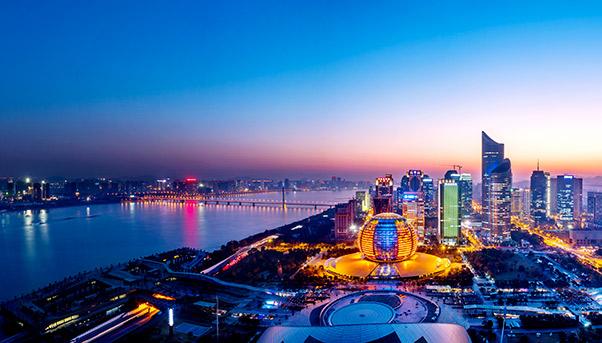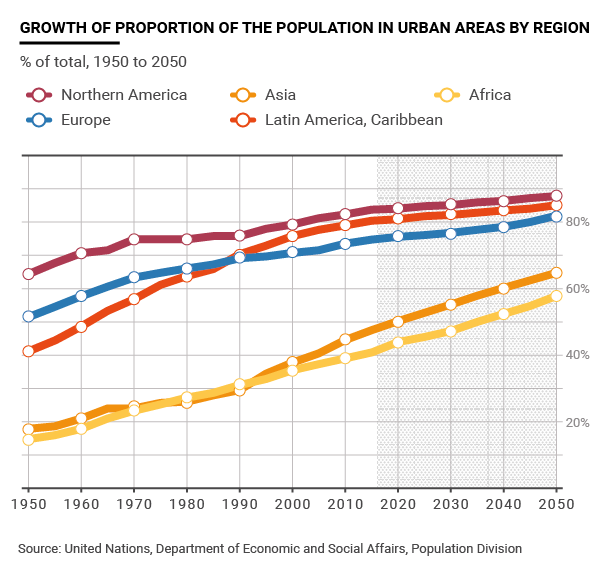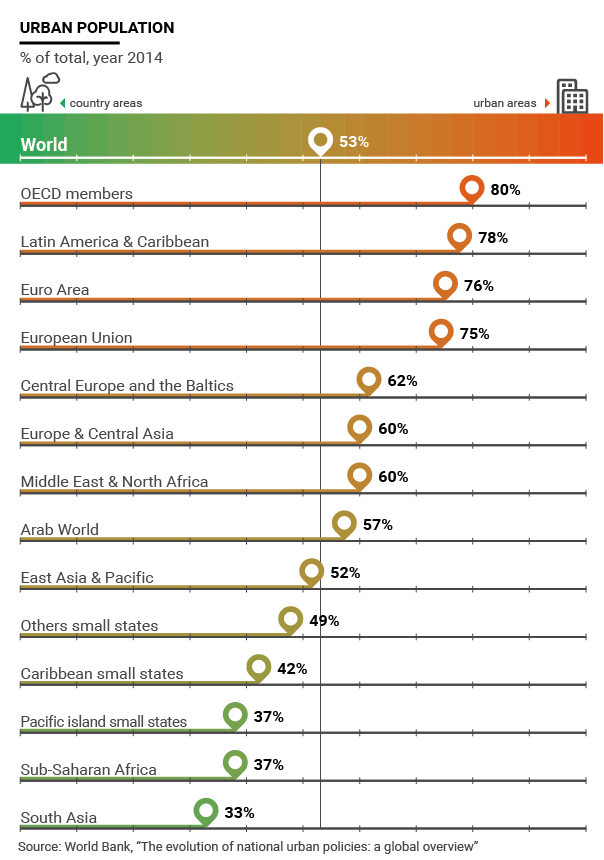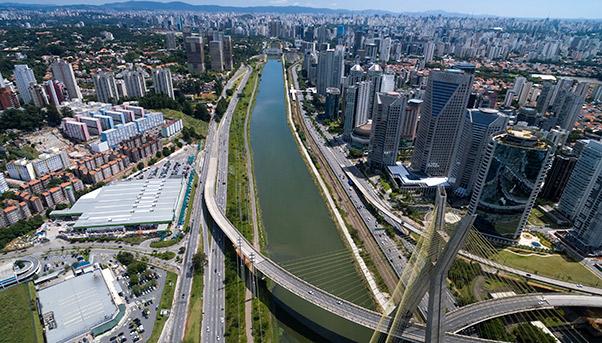
Gujarat is an Indian state that faces west onto the Arabian Sea. Although it might have a rich history in the arts and other cultural manifestations, it will soon come to be known as the urbanized state of India because it will soon have more people living in cities than in villages – a first in the history of the country. As its rate of urbanization is accelerating, Gujarat’s gross domestic product (GDP) is growing at a pro-capita rate that is twice that of the country average.
Yixing is a Chinese city that dates back to the 4th century A.D. but its urban landscape has been completely transformed as it has become a point of reference for the Jiangsu province in the middle of the Nanjing-Shanghai-Hangzhou region with a combined population of 1.2 billion.
On the other side of the globe, Philadelphia is the second biggest city on the U.S. East Coast with 1.5 million residents. It claims to be the greenest city in the country as it pursues its “Greenworks Philadelphia” plan. This ambitious urban development plan promotes environmental sustainability through 166 initiatives that range from reducing the wasteful use of energy to discouraging the use of private cars in favor of public transportation.
These three cities reflect in different ways the boom in infrastructure amid big urban centres and the impact it is having on the lives of their residents. The boom is also putting pressure on governments and construction companies specialized in public works to keep abreast of the pace of this change. It is one of the issues to be discussed in October in Beijing at the “International Conference on Sustainable Infrastructure 2016”. Its organizers – the Chinese Research Academy of Environmental Sciences and the American Society of Civil Engineers – estimate that about seven billion people will be living in cities by 2050 and 60% of these urban areas have yet to be built.

A boom to be managed
If infrastructure is one of the sectors that spurs global economic growth, urban development is one of the motors behind it. What is encouraging the construction of various infrastructure, whether it be a highway or a subway line, is the growing demands of cities in full expansion. A study by the McKinsey consulting firm estimates the world needs to spend $57 trillion by 2030 on infrastructure, most of it in urban centers.
In India, for example, the urban population reached 340 million in 2008 and will hit 590 million by 2030. In order to respond to this boom, the country will need to build 700-900 million square metres of housing every year, and invest $1.2 trillion to build 350-400 kilometres of subway lines and 25,000 kilometres of new roads every year.
In China, the urban population is destined to grow from 636 million in 2010 to 905 million in 2030. By 2050, it will have to invest between €110-125 billion a year to improve urban infrastructure.
But rethinking urban development policy does not only concern countries in the emerging world or those that are experiencing a demographic boom. In the United States, for example, the issue is widely debated, and states as well as cities have started to come up with answers. In Washington, D.C., the Anacostia River Tunnel is one of a series of tunnels designed to mitigate sewer overflows that contaminate nearby rivers.
A few kilometres from Las Vegas, the damming of the Colorado River created Lake Mead, the country’s largest artificial lake used to bring potable water to the city. So the United States joins China, India and many other countries in rewriting infrastructure development policy for the coming decades.
International support
The struggle for development in the coming years will be fought in the cities. These urban conglomerates consume 80% of the goods and energy produced in the world and spew 75% of the carbon emissions. The reason for this is that 80% of the world’s GDP is generated by cities, according to the World Bank.
This is why urban development policy today is one of the most pressing challenges in the “Global Sustainability Agenda” adopted by many international organizations like the United Nations and the Asian Infrastructure Investment Bank. The agenda sets a number of goals to be reached by 2030.
Many cities have already answered the call, embarking on initiatives like the modernization of their public transport systems. Riyadh is overseeing the construction of a massive subway network that will cover 176 kilometres at a cost of $20 billion. Lima, Sydney and Copenhagen are also building or expanding subway networks, the latter with its Cityringen that will carry 240,000 people a day.
Financial institutions such as the Asian Development Bank and the World Bank have been confronting these challenges for years by supporting development. The former is financing urban development projects in some countries like Indonesia where cities are growing at a frenetic pace.
The World Bank meanwhile has a wider playing field, covering everything from Asia to South America to Africa. Vietnam, Jordan, Tanzania, Honduras, Azerbaijan and Pakistan are the latest beneficiaries of urban development projects financed by the bank. These projects cover every part of the world of infrastructure, from buildings to transportation to energy to telecommunications to health services. Demand is very high but the projects supported by the international financial institutions are not enough to satisfy even a minimal part of it. That is because the number of countries that are experiencing rapid urbanization is constantly growing.
A frenetic race
The future of countries facing the greatest amount of urban development in the world is discussed in a report published in early February by the World Bank under the title “The Evolution of National Urban Policies: A Global Overview”. It offers an example of how investment in infrastructure can change the face of a city, and identifies the areas of the world where it is happening.

In South America, Brazil is one of these cases because it experienced urbanization on a bigger scale than any other country on the continent. The process began in 1940s. By 2010, the number of cities with more than 20,000 residents passed from 59 to 867. And the cities with more than one million residents represent 54% of the total population. In 2007, urban development was supported by the “Growth Acceleration Programme”, the most ambitious in the world ($20 billion earmarked) to bring 2.5 million families out of the slums. In 2009, the government launched another initiative for urban development for the middle class called “Minha Casa, Minha Vida” (”My House, My Life”). Its target was even more ambitious: 3.4 million new homes at a cost of €90 billion.

In Africa, there are a number of countries involved in urban development to alleviate poverty and encourage growth. Ethiopia is one of these. The urban population is growing 3.6% a year, with its cities expected to have 42 million new residents by 2050. As an indication of how much the issue is recognized as a critical issue, the first year of a Master’s course in urban development at Addis Ababa University has attracted 3,000 students – a relatively large amount. The government’s investment in the construction of big dams like GIBE III (soon to be inaugurated) or the GERD (the biggest dam in Africa still under construction) is a guarantee to its commitment to improve the quality of life of its people through the supply of renewable energy and the flourishing of industry in big cities like Addis Ababa.
In recent years, Nigeria has been following a similar course. The discovery of oil has allowed it to raise the necessary funds to support projects of urban development. Its National Urban Development Plan, launched in 2012 (but first brought into being in 1992), saw the construction of roads, the introduction of new means of public transportation, the erection of buildings and the improvement of safety in the cities. This commitment culminated in the government’s decision to move the capital from Lagos to Abuja, a city that grew in the 1980s as an alternative to the poverty and congestion of Lagos. The idea was to build safer and more livable cities with greater civic participation. It oversaw the construction of the Cultural Centre and the Millennium Tower, a complex that houses one of the most important museums of African art in the world. It also has auditorium that seats 2,000 spectators.
As Abuja has become an important centre with government organizations and embassies, Lagos has been working on an infrastructure project to make space to receive 250,000 new residents and create 150,000 jobs. Even in this case the government has invested a lot, convinced to be able to transform the city into a metropolis.
The challenge of the future
The deep changes that are radically transforming the face of cities must be managed and shepherded to avoid the collateral effects of overpopulation like traffic congestion, inefficient transportation networks, air pollution and the birth of slums. To confront these risks, the United Nations and the World Bank have identified the course to follow in the “Sustainability Agenda”.
The key points are: fighting climate change, committing cities to develop transportation networks that pollute less, supplying energy to industry in an efficient way, producing renewable energy, using of water resources without wasting them, fostering social inclusion and improving quality of life. They also include building neighborhoods that do not turn into slums, guaranteeing universal access to services from health to transportation, promoting industry that is sensitive to the environment and encouraging technology clusters and the spread of smart technologies. The latter would allow for the exchange of information, Internet access and the sharing of innovative services.
These are the challenges of the future, challenges that must be confronted before the world becomes one big city.

